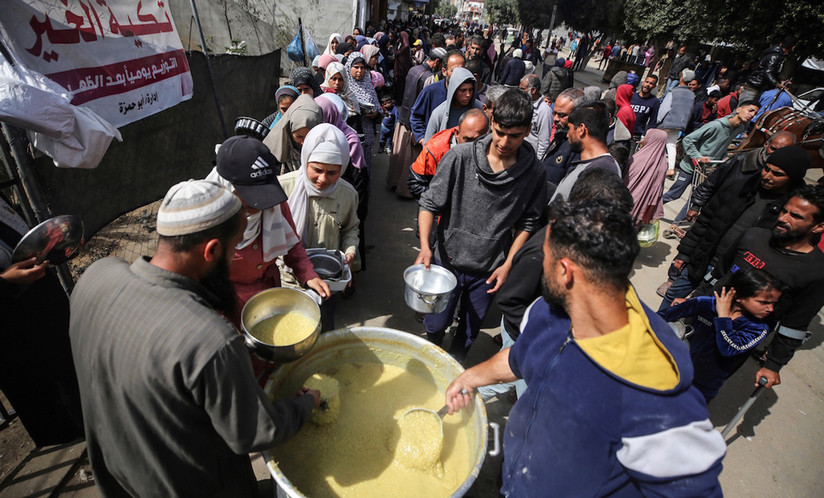The Public Health Crisis in Gaza: The Spread of Disease and Potential for Famine

In the five months of the Israel-Hamas war, the impacts on public health have been profound. The death toll has climbed to over 30,000, which has included an enormous number of civilians, including health care workers.
The health care infrastructure of Gaza has deteriorated, leaving those who are sick, injured, pregnant, or seeking care forced to grapple with a bleak reality. Remaining hospitals are overwhelmed, under-resourced, and understaffed, limiting health care workers from being able to provide life-saving services.
Aid is not reaching those who need it most, with the country on the brink of famine. As of March 7, at least 20 people have died from starvation and dehydration, including a one-day-old infant, and 18 children have died, including 15 who were being treated at Kamal Adwan hospital.
In this article, Dabney P. Evans, PhD, associate professor of global health and director of Emory's Center for Humanitarian Emergencies, and Aryeh Stein, PhD, professor of global health, share their insights on what the latest developments mean for public health.
Assessing the State of Displacement, Destruction, and Disease
“What we know is that the displacement of people has been ongoing, and that people have now been displaced multiple times,” says Evans.
At the start of the conflict, populations were urged to move south, and those residing in the middle of Gaza were also encouraged to move south. “Now we know there is a huge density of people living in the Rafah area [which includes more than 1 million displaced people].”
A March 5 Reuters article reports that only 12 hospitals in the area are “partially functioning,” with just a single partially functioning hospital serving the north and 1.7 million or 75% of Gaza’s population displaced. With large gatherings of people co-existing in close quarters, infectious diseases can get a strong foothold. COVID and respiratory infections are top of mind, but so too are other forms of infectious disease, including those that come from water, sanitation, and hygiene-related infections. As of March 8, 83% of groundwater wells were non-operational and about 57% of WASH-related facilities had been damaged or destroyed, according to the United Nations Office for the Coordination of Human Affairs website.
“We're hearing reports of 50 people in a two bedroom apartment, and it's just really impossible to imagine that there's not some sort of sharing of viruses and diseases,” says Evans. “Malnutrition is also going to make people more vulnerable to infectious diseases. Those with chronic diseases are even more vulnerable, for example, to an infectious disease or malnutrition.
At the same time, more than 300,000 people are still isolated in northern Gaza, where malnutrition has reached crisis levels and aid cannot get through.
Facing Starvation, Famine, and Long-Term Consequences
The threat of famine looms. According to a statement from United Nations World Food Programme Deputy Executive Director Carl Skau on February 28, famine could strike the area as soon as May. One in six children under the age of two are acutely malnourished.
“Children need food to grow,” says Stein. “Children are more susceptible to infections because they haven’t had them yet. Infections are energy intensive. The fever that we get with an infection is the body trying to eliminate the infection and heating. It takes energy to fight infections. If you aren't getting enough food, then the infection wins.”
Undernutrition is responsible for almost half of all deaths of children under five world-wide. Children facing acute malnourishment are at risk of a number of health threats, including “muscle wasting, stunted growth, and medical complications like sepsis, meningitis, diarrhea, and severe anemia.”
Stein notes that there are also long-term social and psychological effects of war, hunger, displacement, and trauma that can play out over a child’s life course and that can present in various ways, including social development and cognition.
“By and large, kids who get the appropriate care in a clinical setting will recover,” says Stein. “Whether they make a complete social and cognitive recovery, depends on the environment they're in. They will have been in the hospital for a while. They will have experienced multiple stressors, some of which are social, and the emotions around being hungry. It also depends on the age of the child and any infections that they may be dealing with. Those who tend to do the worst are the kids who have other comorbidities, making management that much harder.”
Fighting Hunger, Navigating War Logistics
Aid is currently not reaching the areas needing it most in the quantities necessary to prevent famine, though several recent efforts have aimed to increase the level and mode of supply delivery. Prior to October 7, approximately 500 trucks entered Gaza each day delivering food and supplies (including fuel, consumer goods, and medical supplies). Recent reports put the numbers closer to 150 trucks a day, with the World Food Programme urging an increase to at least 300 trucks a day to meet people’s basic needs.
“That is far less than the normal demand,” says Evans. “What we can conclude from that is there's no way that the basic material needs of the population are being met. And the way that we are seeing that show up is in individual cases of malnutrition, as in the cases of these deaths that have been reported as well as population-wide food scarcity and food insecurity.”
Unlike an instance where a natural disaster or drought are preventing deliveries from reaching an area, or where food cannot grow, health consequences of this human-caused emergency can be averted.
“This is not a famine that is occurring as the result of a natural disaster. This is occurring because food supplies and humanitarian assistance have not been able to get to people. It’s really a matter of political will to ensure that the humanitarian assistance can get into the territory of Gaza, and then we can talk about the logistics of getting it distributed equitably and geographically,” said Evans.